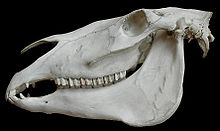- Diastema (dentistry)
-
 Large diastemata between incisors, canines, and molars of a normal horse
Large diastemata between incisors, canines, and molars of a normal horse
Diastema (plural diastemata) is a space or gap between two teeth. Many species of mammals have diastemata as a normal feature, most commonly between the incisors and molars.[1]
Contents
In humans
 Condoleezza Rice, former U.S. Secretary of State, has a prominent diastema
Condoleezza Rice, former U.S. Secretary of State, has a prominent diastema
In humans, the term is most commonly applied to an open space between the upper incisors (front teeth). It happens when there is an unequal relationship between the size of the teeth and the jaw.
Diastema is sometimes caused or exacerbated by the action of a labial frenulum (the tissue connecting the lip to the gum) causing high mucosal attachment and less attached keratinized tissue which is more prone to recession or by tongue thrusting, which can push the teeth apart.
In the Canterbury Tales, Geoffrey Chaucer wrote of the "gap-toothed wife of Bath".[2] As early as this time period, the gap between the front teeth, especially in women, had been associated with lustful characteristics. Thus, the implication in describing "the gap-toothed wife of Bath" is that she is a middle-aged woman with insatiable lust. This has no scientific basis, but it has been a popular assumption in folklore since the Middle Ages.[citation needed]
In Ghana, Namibia, and Nigeria, diastema is regarded as being attractive and a sign of fertility, and some people have even had them created through cosmetic dentistry.[3] In France, they are called "dents du bonheur" ("lucky teeth").[4]
Les Blank's Gap-Toothed Women is a documentary film about diastematic women.
Some well-known people noted for having diastema include models Lauren Hutton and Jessica Hart, American Football player Michael Strahan, actress Anna Paquin, songstress Madonna, late night show host David Letterman, and former U.S. Secretary of State Condoleezza Rice.[2] [3]
Dental Corrections
Diastema is an adjustable dental condition. This includes traditional braces, Invisalign, or direct dental bonding to make the teeth wider and thus fill up the space. One problem with orthodontic correction is relapse: There is a strong propensity for the gap to reappear after treatment.[citation needed] This can be addressed by bonding a permanent retainer to the inside surfaces of the teeth.
Some internet sources sell elastics that are designed to pull the front teeth together and close a diastema. However, orthodontists and cosmetic dentists warn that these techniques tip the teeth rather than move them sideways as they should be moved. In some cases, people using this technique have caused their front teeth to come loose.[5]
Other animals
Most species of herbivorous mammals have a diastema between the front teeth (incisors and canines), if present, and the cheek teeth (molars and premolars). This is also the case for rodents and lagomorphs.
Many myrmecophagous mammals, such as the aardwolf, anteaters, and pangolin have either no teeth, or, in cases like the aardwolf, have large diastemas between their sparse teeth.
See also
- Cosmetic dentistry
- Tooth veneers
References
- ^ Dentistry.about.com
- ^ a b Rachel Dodes (September 8, 2010). "We Don't Mind the Gap: The Fashionable Flash a New Smile". Wall Street Journal. http://online.wsj.com/article/SB10001424052748703720004575478213601248720.html?mod=WSJ_NewYork_NewsReel. Retrieved 2010-09-10.
- ^ a b Midline diastemata in fashion, Bite magazine website, October 14, 2010, Accessed September 10, 2010
- ^ Metro.us
- ^ Mynewsmile.com

This dentistry article is a stub. You can help Wikipedia by expanding it.
